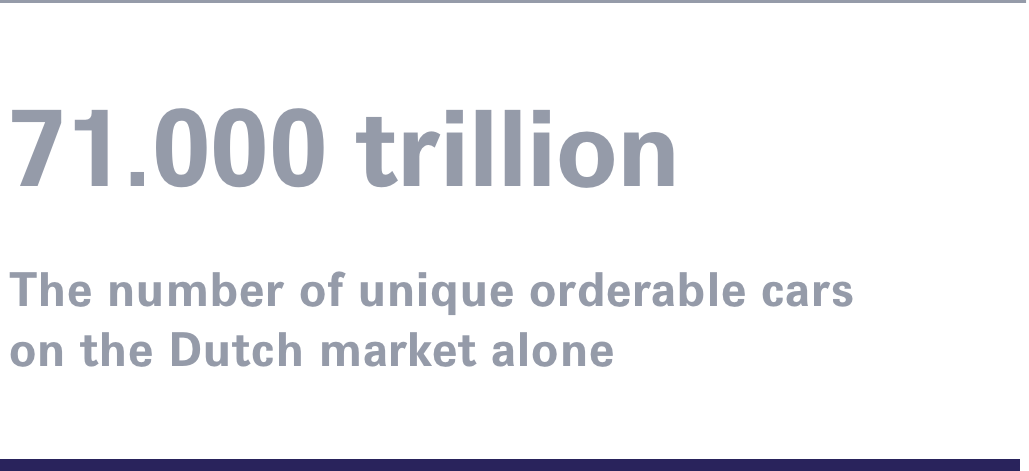The World Light-vehicle Test Protocol (WLTP) is coming. It will be implemented in the EU this September, replacing the current New European Driving Cycle (NEDC). The primary goals: harmonising CO2 emission testing across the globe, and reducing the gap between the calculated and the ‘real world’ fuel consumption of a new vehicle. This is expected to have a great impact on the car leasing industry.

First because labelling the calculation of WLTP ‘complex’ is an understatement. For the (small) Dutch market alone, all combinations of configurable options and accessories result in a mind-boggling 71.000.000.000.000.000 unique orderable cars. Each with their own WLTP-CO2-value as one of the main factors in establishing the leasing price.
Secondly, because none of the vehicle data suppliers currently have any detailed WLTP-related data available. Not one of the OEMs has yet released any relevant information for WLTP unique configuration calculations. This data/information is vital.
How did the WLTP come about? All countries that signed the Paris climate agreement have vouched to reduce their CO2-emission. The connection between fuel consumption and emission is obvious, and the global target for 2020/2021 is 95g/km. Furthermore, in many European countries, you pay tax by the amount of CO2 your car emits. And that’s where the current NEDC-method started failing. At the beginning of this century, there was no noticeable gap between the calculated and ‘real world’ fuel consumption of cars. But when several EU-members tied the height of their taxes to CO2-emission, that quickly changed. The NEDC driving test to establish the actual emission has two phases run over a single load. It doesn’t take a scientist to figure out how to procure the most favourable outcome. Especially hybrid cars perform far better during the test, than on the road. Keeping your emission for a new vehicle under a certain level, meant an instant commercial success; just one extra gramme of CO2 per kilometre can lead to a price difference of up to 475 euro.
Eventually, someone noticed the mismatch between the actual CO2-emission and the official listings of the OEMs. With the current rate, the mismatch is expected to be as high as 50% by 2020/2021.
You could argue that WLTP has a limited life span, since we will all most likely switch to alternative options in the next decade or so. Hybrid cars for instance, or flowcell batteries and hydrogen; options which emit considerably less. However, that is the future and WLTP is here now.
Contrary to NEDC, the WLTP doesn’t have just two phases run over a single load. It has four phases and runs in two load conditions. This graph illustrates the difference.
The OEMs need to adapt to WLTP. This new way of testing impacts the designing and marketing of all new vehicles. And the legal impact in particular, appears to draw a lot of attention; lawyers are trying to establish how much leeway the WLTP-rules and procedures offer. No wonder the OEMs are putting maximum pressure on Brussels to delay the introduction of WLTP.
In other words, it is complicated, and we don’t have to count on a quick fix. Instead, we expect to see a learning curve, which will gradually guide the market through the necessary changes.
The OEMs also aim for as few (expensive and time-consuming) tests as possible, which indicates that the span of a WLTP-family may be large. The test results will range from the smallest emission on a ‘stripped’ car, to the maximum emission on the heaviest and most complete car in the family. Resulting in an even more challenging task to calculate the value of a unique WLTP.
As a Dutch firm, BetterBe believes in the power of the free market, and we have reason to believe that it will all be well in the end. So, let’s talk about solutions.
The Netherlands will be the first to introduce WLTP-based taxation. The legislation isn’t ready yet, but the government did set a date: January first, 2019. With our BLS (BetterBe Leasing Services), we created the only available platform in the world, which can provide the massive specialised calculations needed for WLTP. A powerful and elegant solution, developed in the Dutch tradition of venturing out and innovate. And because we make all of our services available online, car leasing company’s around the world can have the BLS at their fingertips.
Specialists from BetterBe are in close contact with major OEMs to be early involved in the WLTP data and algorithm development. We are also aligned with all the major vehicle data suppliers, to prepare data modelling and data exchange for WLTP.
Our preliminary WLTP-algorithm-simulations have confirmed there are no technical limitations. Our BLS can already calculate your lease price real-time, to generate an individual quotation of a makeable car – including all configurations, from model and make to the desired colour and accessories – within seconds. All we need is the data. And we are confident that in the end, getting data won’t be a problem in our data-driven world.